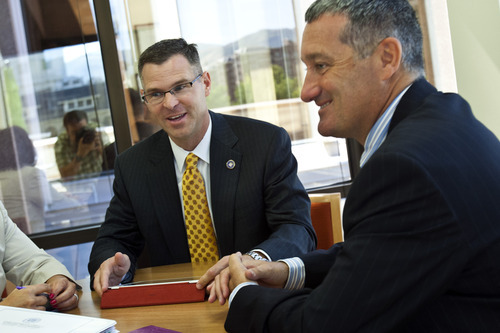This is an archived article that was published on sltrib.com in 2012, and information in the article may be outdated. It is provided only for personal research purposes and may not be reprinted.
Spencer Eccles clearly was in an upbeat mood during a meeting of the Governor's Office of Economic Development board a few weeks ago.
He had reason to be. Eccles, GOED's executive director, had some very good news to report. His agency, which oversees all business, tourism and film development for the state of Utah, had hit another home run. In the fiscal year that had just ended, GOED had authorized tax incentives to two dozen companies that had pledged to create a record 9,019 jobs, — 18 percent more than in the previous year, which also was a record.
What Eccles and Christopher Conabee, who runs corporate recruitment for GOED, didn't tell the board was just as remarkable. Over the past seven fiscal years, the state has agreed to forgo $646 million in taxes in order to incentivize the creation of thousands more jobs in seven industrial sectors, including aerospace, financial services, life sciences and software development.
But whether that's a bargain or an extravagance isn't clear because there seems to be no national standard to measure the costs of tax incentives against their benefits. In fact in April, the Pew Center on the States issued a report saying most states, including Utah, don't really know if business tax incentives are boosting job growth.
That aside for a moment, what is certain is that the howling recession and constrained recovery have actually played into Utah's hands. Companies that might have overlooked the state in better times are now choosing Utah, whose economy, stable tax rates, regulatory environment and dependable workers are increasingly viewed as safe harbors in an otherwise bleak landscape.
"I think the economic downturn, in the long run, in terms of companies that are looking around, [has helped Utah]. There are companies that are expanding here that may not have done it if it was all blue sky like it was in 2005 and 2006," Eccles said later.
Back in their heydays, "they may not have thought about, 'Hey, we need to be more efficient and more productive.' This downturn has forced discipline on companies and on people that there may have been changes that needed to happen," Eccles said.
—
By the numbers, the incentives have apparently produced impressive results without exposing taxpayers to risk. Since 2006, scores of companies, including household names such as Adobe, Goldman Sachs, eBay, IM Flash, ITT and Oracle, have promised to create more than 37,000 new jobs in the state within some fixed span of time, usually five years to 20 years. Most will pay well, by Utah standards. GOED says each job must pay at least 25 percent more than the average wage of the county where it is created. In Salt Lake County, where about half of the jobs incentivized by the agency are being developed, that works out to about $55,640 a year, according to U.S. Bureau of Labor Statistics data.
"We are regularly approached by other states that offer incentives to move or expand our operations in their area," said Jon Stone, a spokesman for the U.S. operations of Fresenius Medical Care. GOED approved a $4.1 million incentive for Fresenius in 2006 when the German health care firm agreed to establish 1,100 new jobs at its existing Ogden plant. More than 450 jobs have already been created, the company says. Each worker should take home at least $42,000 a year, according to the BLS data.
"An important and driving factor as to whether we choose to expand to a new or existing site is whether it is located in an area that presents a sustained, positive economic environment," Stone said in an email.
Eccles is certain that the incentives are free of risk. Companies don't get rebates until they show they have carried out their pledges. They also must pay taxes to the Tax Commission before a rebate check is cut. And they can't receive more than 30 percent of a rebate in any year, which softens the impact on tax revenue.
Still, there is a cost. The taxes that Utah has agreed to do without average out to more than $17,000 per job. It is hard to discern whether that's a big number or not because of the lack of national standards to compare Utah against.
In its report, the Pew Center didn't take a stand on whether state tax incentives are good or bad economic policy. Instead, it looked at what states were doing to evaluate the incentives, including measuring economic impact and devising ways to draw clear conclusions.
—
Nobody knows how many billions of dollars are spent annually on tax incentives for economic development, Pew said, adding that every state has at least one program and most have several. Even so, "no state regularly and rigorously tests whether those investments are working and ensures lawmakers consider this information when deciding whether to use them, how much to spend, and who should get them," the nonpartisan group said.
Looking back at his 36 years at the Office of the Legislative Auditor General, John Schaff can't remember a time when GOED's tax incentives got a thorough going-over.
"I don't know whether we have or haven't," Schaff said, adding, "You would think it would be something to look at."
The Utah Taxpayers Association, a spending watchdog, hasn't seen a need to examine GOED's incentives or take a position on their value.
"Our understanding in working with them over the years is that GOED offers post-performance incentives that are designed to provide reasons for people to make investments that otherwise wouldn't happen in Utah, but that really is the extent of what I can say about what GOED does," said Royce Van Tassell, the association's vice president.
Eccles insists rebates are a good buy. A GOED accountant reviews each company's performance to ensure compliance before the Tax Commission is instructed to issue a rebate, he said. The agency also looks at more than jobs to determine the actual economic value of its incentives, he said. Because tax rebates are less than taxes paid on profits, payroll and purchases, GOED also considers the net revenue the state receives, which Eccles said brings the $17,000-per-job estimate down to $1,500 to $5,000.
"It's well worth it to pay a little bit back on the money that the company is paying into the state," Eccles said. "You are reducing the total [tax revenue], but at the same time, were it not for the incentive, you would basically have no revenue."
—
On top of additional tax revenue, the state gets an enormous infusion of capital spending on buildings and equipment, according to GOED data. Since 2006, capital spending commitments total more than $10 billion. Software giant Adobe, for example, is constructing a $100 million building for a Utah headquarters in Lehi. Its total capital commitment is $298 million. In return for creating 927 jobs by 2030, Adobe will get a $40 million tax rebate.
Incentives have become a fixture in the hyper-competitive hunt for jobs. Eccles said companies expect them. But, he adds, GOED doesn't have that conversation until late in the game. That's because Utah's incentives often pale in comparison to those of bigger states. Instead, GOED recruiters talk up Utah's advantages, such as business costs, quality of life, geographic location, taxes.
Outdoor sports equipment manufacturer Amer Sports moved three companies — Salomon, Suunto and Atomic, from Portland, Ore.; Carlsbad, Calif.; and Amherst, Mass., respectively — to Ogden after GOED approved a $7.9 million tax incentive in 2006. The company already has produced more than half of the 230 jobs it promised to create within 10 years.
"We were going to spend a fair amount of money on the relocations," said Mark Taylor, director of finance at Amer Sports, who estimated the company spent $3 million to $4 million on the move. "I would say that the GOED and EDCUtah (Economic Development Corporation of Utah) made it very clear from the beginning that they wanted companies like us. That was obvious from the incentive package that they put together."
Edwards Lifesciences, an Irvine, Calif., heart valve maker, received an $11.5 million incentive in 2009 in return for promising to create 1,300 jobs over 15 years at a new manufacturing plant in Draper that would replace a smaller facility in Midvale.
The plant opened in 2010. It employs 375 workers, up from 270 workers a year ago. Spokeswoman Amanda Fowler wouldn't say when Edwards expects to fill out its workforce. But "it's going great," she said of the plant. "There were a few things that led to our decision, but [the incentive] was one of them."
For Eccles, although the rebates may seal the deal, there's more at work in getting companies to invest.
That's why Gov. Gary Herbert, in touting the state, is quick to publicize the business accolades Utah has received from Forbes, Fortune and other quarters.
"There is no question in my mind that the incentive program is effective in getting us over the last mile," Eccles said. "[But] it's not what opens up the doors most of the time."
pbeebe@sltrib.comTwitter: @sltribpaul Top 10 recipients of GOED tax incentives (fiscal 2006-2012)
The Governor's Office of Economic Development has approved tax rebates totaling $467 million to the companies during the seven-year span, which ended June 30. The rebates will be paid over fixed periods of up to 20 years. To receive rebates, the companies must create 14,500 jobs. Number in parentheses is the number of tax rebate agreements.
Source: Governor's Office of Economic Development —
GOED's track record
The number of jobs that the Governor's Office of Economic Development has incentivized with tax rebates has increased almost five-fold since the Great Recession.
• 2006: 5,887 jobs
• 2007: 1,814
• 2008: 4,836
• 2009: 4,026
• 2010: 4,222
• 2011: 7,638
• 2012: 9,019
Source: Governor's Office of Economic Development











